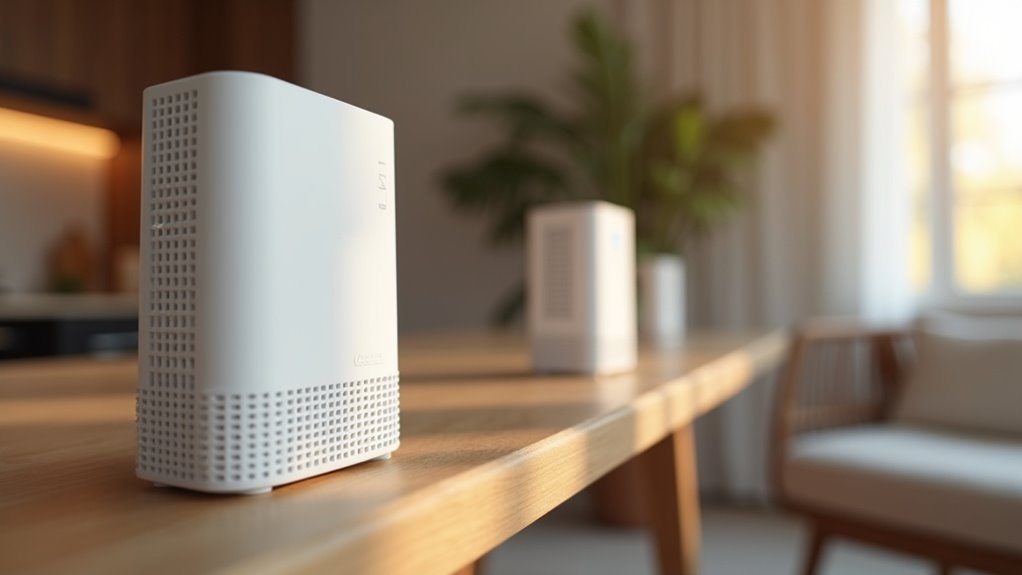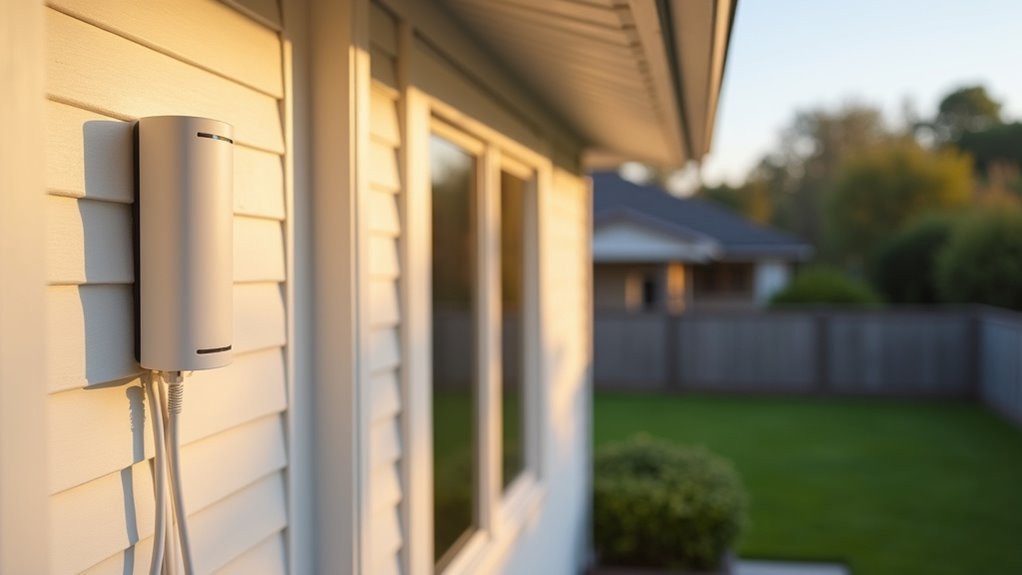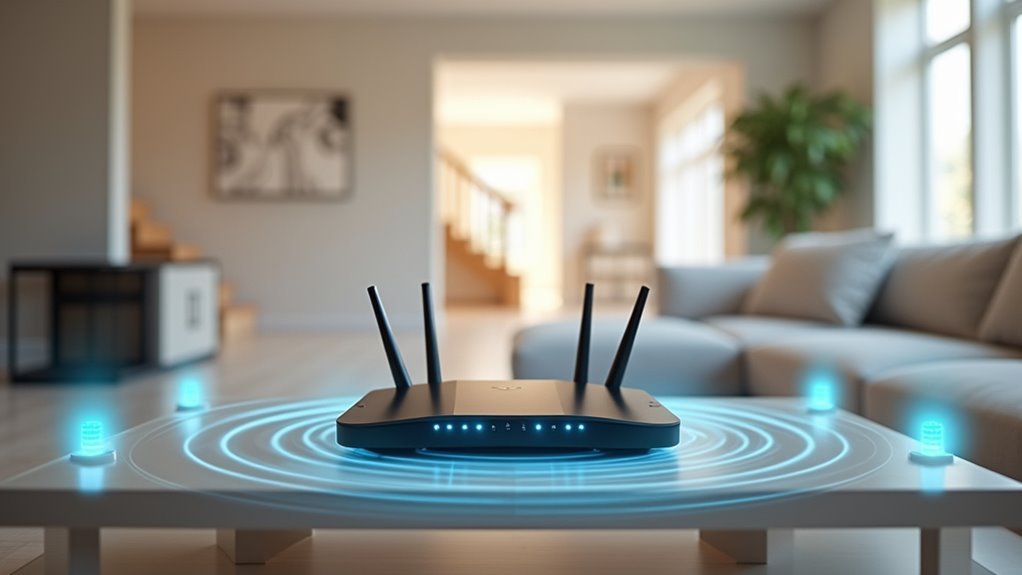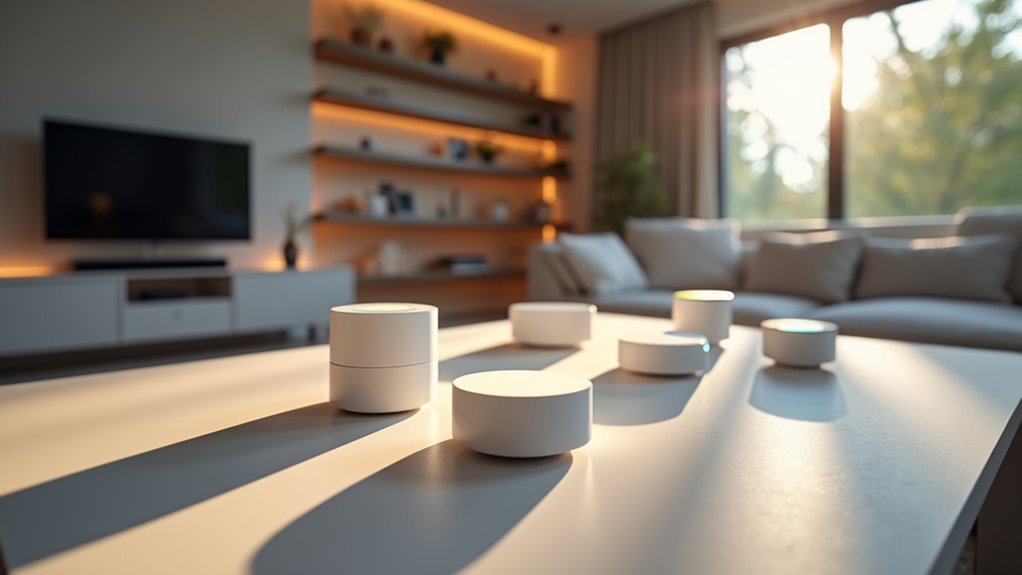You’ve probably noticed your WiFi signal weakening in certain rooms or dropping entirely in your backyard. While your mesh system was supposed to solve these connectivity issues, dead zones still persist throughout your property. The good news is that expanding your mesh coverage doesn’t require starting from scratch or investing in expensive equipment. These seven strategic approaches will transform your spotty connection into extensive coverage that reaches every corner.
Upgrade to a Dedicated Mesh System Instead of Range Extenders

While range extenders might seem like an affordable solution for weak WiFi signals, upgrading to a dedicated mesh system will transform your entire home network experience.
Unlike traditional extenders that create separate networks and halve bandwidth, mesh systems provide seamless coverage with a single network name throughout your home. You’ll eliminate frustrating login disruptions as your devices move between rooms.
Mesh systems feature dedicated backhaul radios that enhance communication between nodes, delivering superior performance compared to extenders. They integrate effortlessly with your existing router and grow with your needs.
Instead of managing multiple network credentials, you’ll enjoy one unified connection that adapts to challenging layouts. This upgrade guarantees reliable, fast connectivity that greatly improves your daily internet experience.
Add Additional Mesh Nodes to Your Existing Network
When you’re ready to expand your existing mesh network, you’ll need to focus on three key areas to maximize your coverage improvement.
Strategic node placement guarantees you eliminate dead zones while maintaining strong connections between all devices in your network.
You’ll also want to verify hardware compatibility and properly configure your network settings to seamlessly integrate the new nodes.
Strategic Node Placement
As you expand your mesh network, adding nodes strategically becomes essential for eliminating dead zones and maximizing coverage throughout your home.
When strategically placing mesh nodes, position them within 30-50 feet of existing nodes to maintain ideal communication and prevent signal degradation. You’ll want to elevate your mesh nodes on shelves or high furniture to enhance signal coverage and reduce obstructions from walls.
Use a network monitoring tool to identify weak connectivity areas, guiding you to place additional nodes where they’re needed most. This targeted approach considerably improves overall network performance.
Verify all mesh nodes share identical network names and security credentials, enabling seamless connectivity as your devices move throughout the coverage area without interruption.
Compatible Hardware Selection
Beyond proper positioning, selecting compatible hardware forms the foundation of successful mesh network expansion.
When choosing additional mesh nodes, you’ll need to confirm they’re compatible with your current system, as different brands typically don’t work together seamlessly. Match Wi-Fi standards between your existing setup and new nodes—whether Wi-Fi 5 or Wi-Fi 6—to maintain peak speed throughout your network.
Evaluate each node’s coverage area specifications to confirm they’ll effectively extend your reach.
Prioritize mesh nodes with dedicated backhaul capabilities, which dramatically improve communication efficiency between devices and boost overall network speed. These dedicated channels prevent data bottlenecks that can slow your entire system.
Always consult manufacturer’s guidelines before purchasing to verify compatibility and performance expectations for your specific setup.
Network Configuration Setup
Once you’ve selected compatible hardware, you’ll configure your network to seamlessly integrate the new nodes. Use your existing network name and security credentials to maintain device connections without requiring re-authentication.
Strategic placement is vital—position new mesh nodes in weak signal areas while guaranteeing they’re within range of existing nodes for best connectivity.
If your system supports dedicated backhaul, activate this feature to enable direct node-to-node communication, reducing bandwidth conflicts.
Monitor signal strength through your mesh system’s app, which provides positioning insights for maximum WiFi coverage. Keep all nodes updated with the latest firmware updates to guarantee compatibility and peak performance.
Regular monitoring helps identify placement adjustments needed to maintain seamless coverage throughout your expanded network.
Optimize Mesh Node Placement Throughout Your Home
You can’t just randomly scatter mesh nodes around your house and expect peak performance.
Strategic placement requires positioning your central hub in an open, elevated location while minimizing walls and furniture between nodes.
The key is maintaining proper distances between each node to create seamless coverage without dead zones or signal overlap.
Central Hub Positioning
While many people focus solely on the number of mesh nodes they purchase, the strategic placement of your central hub determines whether your entire network succeeds or fails.
Position your central hub in your home’s center to maximize coverage efficiency and minimize distances between nodes. Elevate it on a shelf or high surface to improve signal dispersion and reduce obstructions from furniture and walls.
Keep your mesh WiFi system away from interference-causing electronics like microwaves and cordless phones to enhance network performance.
Regularly assess your mesh nodes’ positioning, maintaining 30-foot distances for ideal signal strength. Use network analysis tools to monitor connectivity and make placement adjustments as needed, ensuring seamless coverage throughout your entire home.
Minimize Physical Obstructions
Beyond positioning your central hub effectively, strategic placement of individual mesh nodes throughout your home creates the foundation for ideal network performance. To maximize signal propagation, you’ll need to minimize interference from physical obstructions that weaken your connection.
Elevate mesh nodes on shelves or furniture to reduce obstacles blocking your signal. Position them in open areas rather than enclosed spaces, and maintain 10-15 feet distance between nodes to prevent signal overlap. Avoid placing units near electronic devices like microwaves or cordless phones that disrupt WiFi performance.
| Obstruction Type | Signal Impact | Placement Solution |
|---|---|---|
| Walls/Furniture | High reduction | Open positioning |
| Metal objects | Severe blocking | Maintain distance |
| Electronics | Active interference | Separate completely |
| Floor level | Limited range | Elevate units |
Use your system’s app to monitor signal strength and make strategic placement adjustments.
Maintain Optimal Node Distance
Maintaining 30-50 feet between mesh nodes creates the sweet spot for perfect network performance throughout your home. This perfect distance guarantees you’ll maintain a strong signal while preventing interference that degrades connectivity.
To enhance Wi-Fi coverage and minimize dead zones effectively, strategic positioning makes all the difference.
- Place nodes in open spaces away from thick walls and metal objects that obstruct signal propagation
- Install units on elevated surfaces like shelves or wall mounts for better Wi-Fi signal strength distribution
- Test connectivity at various locations using mobile apps to identify best placement zones
- Avoid clustering nodes too closely together, which creates unnecessary interference patterns
- Regular repositioning nodes helps adapt to furniture changes and maintains peak performance levels
Configure Dual-Band Frequencies for Maximum Performance
One of the most effective strategies for maximizing your mesh WiFi network’s performance involves properly configuring dual-band frequencies to leverage both 2.4GHz and 5GHz bands. You’ll want to use the same SSID for both frequencies, allowing devices to automatically switch between bands for a stable connection.
| Feature | 2.4GHz Band | 5GHz Band |
|---|---|---|
| Range | Longer range, better wall penetration | Shorter range, less penetration |
| Speed | Slower speeds | Faster speeds |
| Interference | More congested | Less congested |
| Best Use | Distant devices, IoT sensors | Close devices, streaming |
Enable band steering technology on your router to automatically guide device connections to the appropriate frequency band. This reduces congestion on the 2.4GHz band while directing high-bandwidth devices to 5GHz. Regular monitoring helps optimize network performance across your entire mesh WiFi network.
Install Outdoor Mesh Access Points for Extended Coverage

When your indoor mesh network reaches its limits, installing outdoor mesh access points can dramatically extend WiFi coverage to patios, gardens, garages, and other exterior spaces.
These specialized devices create a seamless mesh network that allows your devices to connect without switching between different networks, maintaining consistent connectivity as you move around your property.
Key benefits of outdoor mesh access points include:
- Weather-resistant housing protects against rain, snow, and extreme temperatures
- Dedicated backhaul radio communicates directly with your main router
- Coverage extension up to 50 meters from your home
- Ethernet connectivity provides a stable connection to your primary network
- Seamless roaming eliminates dropped connections when moving between coverage areas
Update Mesh Router Firmware and Network Settings
Keeping your mesh router’s firmware current serves as the foundation for top network performance and security. You can update mesh router firmware through your router’s web interface or mobile app, where you’ll find available updates and performance enhancements.
Enable automatic firmware updates to streamline maintenance and guarantee peak functioning without manual intervention.
Beyond firmware, adjusting network settings greatly impacts your mesh system’s effectiveness. You can modify frequency bands and Wi-Fi channels to reduce interference and boost connectivity across your entire network.
These tweaks help eliminate dead zones and connection drops.
Always review release notes when updates become available, as manufacturers include valuable information about new features and enhancements that’ll maximize your mesh network’s coverage potential.
Position Your Main Router in the Optimal Central Location

After refining your firmware and network settings, your mesh router’s physical placement becomes the next determining factor in achieving peak coverage.
Finding the best location for your main router greatly impacts your WiFi signal strength throughout your home.
Position your router centrally to guarantee equal signal distribution to all areas. You’ll want to minimize obstructions by avoiding heavy electronic devices that create interference, such as microwaves and cordless phones.
Elevate your router on shelves or high furniture to reduce wall and furniture interference.
- Place router in open, central area of your home
- Elevate on shelf or high furniture for better reach
- Keep away from microwaves and cordless phones
- Avoid windows and exterior walls to prevent signal loss
- Regularly assess coverage and adjust location as needed
Frequently Asked Questions
How Can I Boost My Mesh Wifi Signal?
You can boost your mesh WiFi signal by adding strategically placed nodes, updating firmware regularly, positioning devices in open elevated areas, and ensuring they use dedicated backhaul radios for peak performance.
How to Extend Wifi Range With Mesh?
You’ll extend WiFi range by strategically placing additional mesh nodes throughout your home, ensuring they’re positioned effectively to eliminate dead zones and provide seamless connectivity across all areas.
How to Maximize Mesh Wifi?
You’ll maximize mesh WiFi by placing nodes in open areas away from obstructions, using dedicated backhaul connections, maintaining consistent network credentials, updating firmware regularly, and monitoring performance to optimize placement.
Can I Add More Nodes to a Mesh Wifi?
Yes, you can add more nodes to your mesh WiFi system. Most mesh networks are designed to be scalable, so you’ll simply need to place new nodes within range of existing ones for seamless expansion.





Leave a Reply